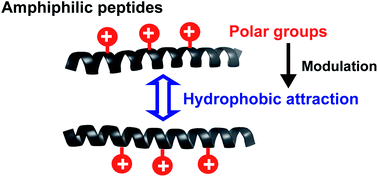A minireview on the perturbation effects of polar groups to direct nanoscale hydrophobic interaction and amphiphilic peptide assembly
Abstract
Hydrophobic interaction provides the essential driving force for creating diverse native and artificial supramolecular architectures. Accumulating evidence leads to a hypothesis that the hydrophobicity of a nonpolar patch of a molecule is non-additive and susceptible to the chemical context of a judicious polar patch. However, the quantification of the hydrophobic interaction at the nanoscale remains a central challenge to validate the hypothesis. In this review, we aim to outline the recent efforts made to determine the hydrophobic interaction at a nanoscopic length scale. The advances achieved in the understanding of proximal polar groups perturbing the magnitude of hydrophobic interaction generated by the nonpolar patch are introduced. We will also discuss the influence of chemical heterogeneity on the modulation of amphiphilic peptide/protein assembly and molecular recognition.

- This article is part of the themed collection: 2021 Reviews in RSC Advances


 Please wait while we load your content...
Please wait while we load your content...